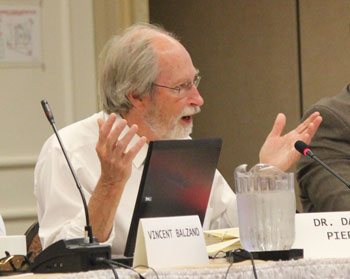Fishery Managers to Track Wind
Energy Development
by Laurie Schreiber

“I strongly believe we should comment on these wind farm initiatives. BOEM comes to the council meetings periodically to give us updates and seek our input, so it would be negligent on our part not to respond.” – David Pierce, a NEFMC member who represents Massachusetts.
NEWPORT, R.I.—At its Dec. 4 meeting, the New England Fishery Management Council (NEFMC) agreed to track and comment on wind energy draft environmental impact statements for areas off Martha’s Vineyard and in the New York Bight.
According to a NEFMC press release, NEFMC staff has been tracking offshore wind development through a joint NEFMC, National Marine Fisheries Service (NMFS), and Mid-Atlantic Fishery Management Council (MAFMC) wind team. The group comments on research initiatives, environmental review, and planning for future leasing. Members also collaborate on analyses and information related to fisheries and fish habitats to provide to the U.S. Department of Interior’s Bureau of Ocean Energy Management, which regulates offshore wind energy development.
These wind farms
will have some
rather dramatic impact
on where fisheries
will occur and
on fishing grounds
that will be lost.
– David Pierce,
NEFMC member.
At its Dec. 4 meeting, NEFMC considered whether to submit comments on the forthcoming Vineyard Wind DEIS, perhaps jointly with MAFMC.
NEFMC staffer Michelle Bachman told NEFMC that NMFS has
submitted data to BOEM about fishing activity, primarily the surf calm and scallop fisheries, in the New York Bight area.
“Some of those areas are quite important from the fisheries perspective,” she said.
“I strongly believe we should comment on these wind farm initiatives,” said David Pierce, a NEFMC member who represents Massachusetts. “BOEM comes to the council meetings periodically to give us updates and seek our input, so it would be negligent on our part not to respond, because these wind farms will have some rather dramatic impact on where fisheries will occur and on fishing grounds that will be lost, in addition to survey tows that will no longer be possible where they cannot go inside wind farm arrays to survey. Surveys are very important for the overall assessments we have.”
NEFMC voted to develop comments to BOEM on the Vineyard DEIS as it relates to resource habitat and to the fisheries themselves.
In April 2018, BOEM published a call for nominations from companies interested in commercial wind energy leases within the proposed area in the New York Bight. This region represents an area of shallow waters between Long Island (to the north and east) and the New Jersey coast (to the south and west). According to information on BOEM’s website, BOEM received a construction and operations plan submission from Deepwater Wind South Fork LLC for up to 15 turbines that connect via a transmission cable to a grid in East Hampton, N.Y on the east end of Long Island. The project is approximately 19 miles southeast of Block Island, R.I. Overall, there are two renewable energy efforts underway offshore New York.
The “Call Areas” under consideration in the New York Bight region are delineated as Fairways North, Fairways South, Hudson North, and Hudson South. The four Call Areas comprise approximately 2,047 square nautical miles.
With regard to the Vineyard region, on Dec. 7, 2018, BOEM published a notice of availability in the Federal Register on for the Draft Environmental Impact Statement that was developed to determine whether to approve, approve with modifications, or disapprove the Construction and Operations Plan submitted by Vineyard Wind LLC. The COP describes Vineyard Wind’s proposed project, which is to construct and operate an approximately 800-megawatt wind energy facility offshore Massachusetts.
Vineyard Wind submitted its COP in December 2017. At its nearest point, the project area is approximately 14 miles from the southeast corner of Martha’s Vineyard and a similar distance from the southwest side of Nantucket. Water depths where the turbines would be located range from 121 to 161 feet.
According to a release issued by BOEM on Dec. 14, 2018, BOEM completed the nation’s eighth and highest-grossing competitive lease sale for renewable energy in federal waters. The lease sale offered 390,000 acres offshore Massachusetts for potential wind energy development and drew competitive winning bids from three companies totaling $405 million in winning bids. If fully developed, the areas could support 4.1 gigawatts of commercial wind generation, enough electricity to power nearly 1.5 million homes.
Provisional winners of the lease sale are:
• Equinor Wind US LLC, 128,811 acres, winning bid $135 million
• Mayflower Wind Energy LLC, 127,388 acres, winning bid $135 million
• Vineyard Wind LLC, 132,370 acres, winning bid $135.1 million
The three lease areas auctioned off are located 19.8 nautical miles from Martha’s Vineyard, 16.7 nautical miles from Nantucket, and 44.5 nautical miles from Block Island.
The lease will have a preliminary term of one year, during which the lessee may submit a Site Assessment Plan to BOEM for approval. The SAP will describe the facilities (e.g., meteorological towers or buoys) for the assessment of wind resources and ocean conditions. Following approval of a SAP, the lessee will then have four and a half years to submit a Construction and Operations Plan to BOEM for approval. The plan will provide a detailed proposal for the construction and operation of a wind energy project within the lease area.
Once BOEM receives a COP, it will conduct an environmental review of the proposed project and reasonable alternatives. If BOEM approves the COP, the lessee will then have 33 years to construct and operate the project.
Before the December 2018 lease sale, the highest grossing offshore wind lease sale was held in December 2016 for the lease area offshore New York that received a winning bid of over $42 million.
After the recent auction, BOEM has 15 active wind leases. These lease sales have generated more than $473 million in winning bids for nearly two million acres in federal waters. Money received from offshore wind lease sales go to the United States Treasury.
